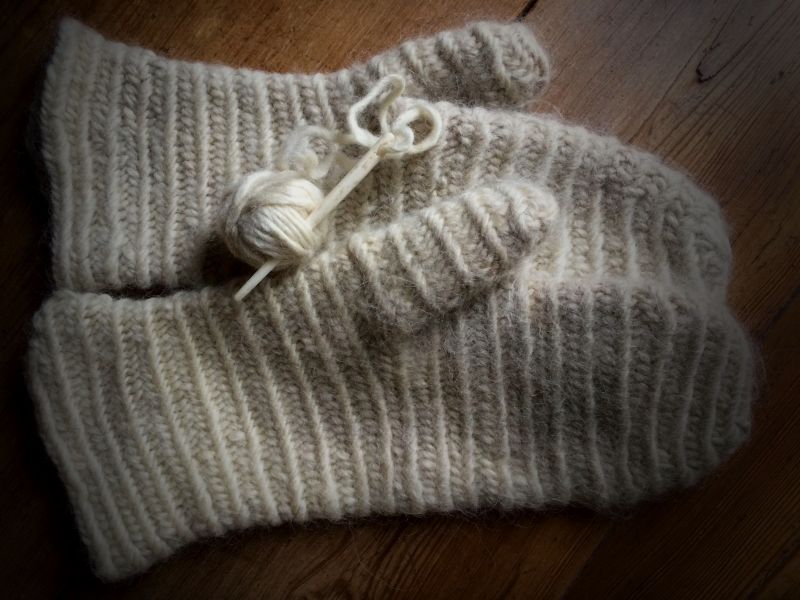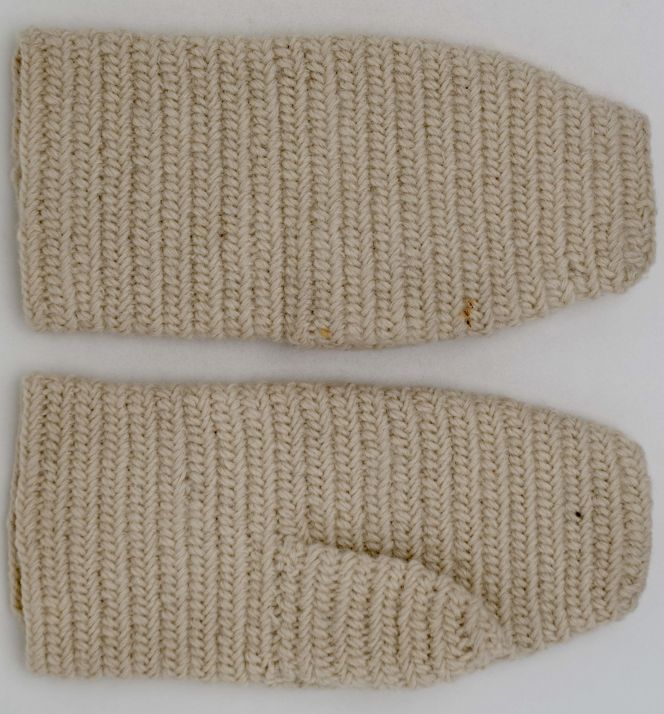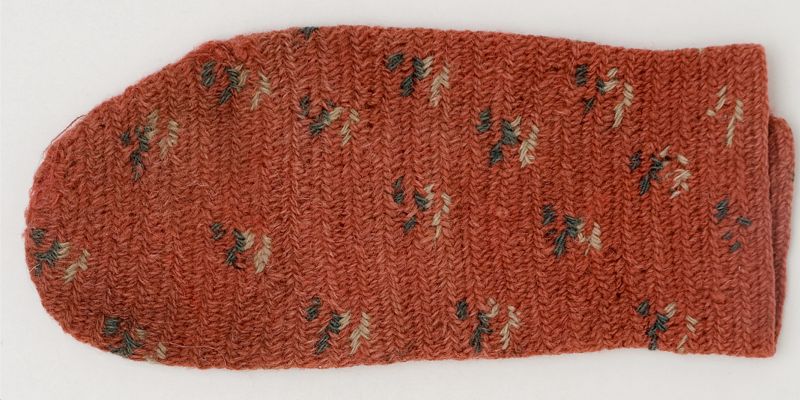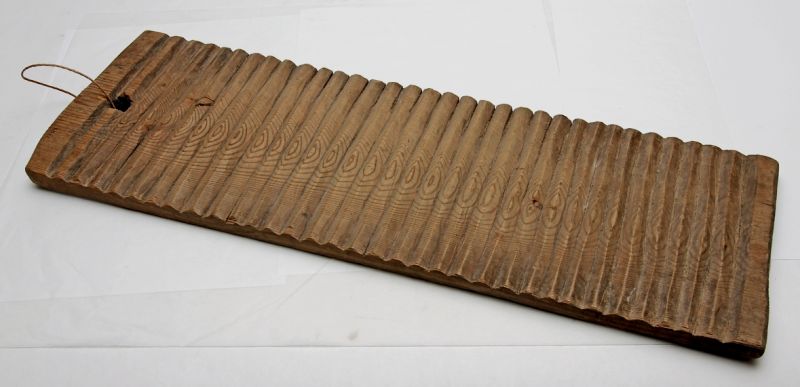ikfoundation.org
The IK Foundation
Promoting Natural & Cultural History
Since 1988


 Crowdfunding Campaign
Crowdfunding Campaignkeep knowledge open, connected, and growing on this textile history resource...
HISTORICAL REPRODUCTIONS
– A Case Study of Nålbindning/Needle-binding in Sweden
The needle-binding technique, so-called Nålbindning (in Swedish), was common in the Nordic countries already during the Iron Age and continued to be so in some areas up to the early 20th century, a technique used for socks, mittens and other small garments. The historical perspective of such hands-on skills learned from one generation to the next came to be part of the handicraft tradition in many local communities. Wool, with its warming qualities, was a particularly important textile fibre in these northern regions, as was cow-hair or horsehair, which is suitable for soles on boots or shoes. All were made in this textile technique. This essay aims to share the experience of reproducing a pair of woollen mittens together with a brief historical introduction and some further geographical perspectives, used materials and tools, embroidered decorations, and the variation of names linked to this sort of handicraft.
 My attempt for this pair of male-sized mittens in the nålbindning technique was made with the illustrated bone needle and a thick single ply white woollen yarn. Thereafter, this pair of mittens was slightly felted in warm soapy water to create a compact, hard-wearing and warm woollen surface. The technique results in a sort of double thickness with elasticity, formed of loops. From my practical experience it is somewhat more laborious to master – than both knitting and crochet – with the various twists and turns with the needle assisted by one’s thumb, which are easy to forget if not practised regularly. To be compared with the 19th century mittens below, which has been an inspiration for my reproduction. (Private ownership. Mittens in nålbindning and photo: Viveka Hansen).
My attempt for this pair of male-sized mittens in the nålbindning technique was made with the illustrated bone needle and a thick single ply white woollen yarn. Thereafter, this pair of mittens was slightly felted in warm soapy water to create a compact, hard-wearing and warm woollen surface. The technique results in a sort of double thickness with elasticity, formed of loops. From my practical experience it is somewhat more laborious to master – than both knitting and crochet – with the various twists and turns with the needle assisted by one’s thumb, which are easy to forget if not practised regularly. To be compared with the 19th century mittens below, which has been an inspiration for my reproduction. (Private ownership. Mittens in nålbindning and photo: Viveka Hansen). Traditional white woollen mittens in the nålbindning technique. This pair of mittens was donated to the Nordic Museum in 1933 by the Countess Ulla von Celsing at Biby manor house, situated about 100 kilometres from Stockholm. Interestingly, this manor house had a large sheep-breeding farm, so-called ‘schäferi’, particularly substantial in size from the 1820s to the 1860s. Wool samples of various qualities were also meticulously arranged in the account books. Such a sample book from 1860 has been presented in the book ‘Biby: Ett fideikommiss berättar’ (see sources). One may assume and it is even highly likely, that the wool as well as the ready-made mittens, originate from the 19th century sheep-breeding period at Biby or the farms placed under this manor house. (Courtesy: The Nordic Museum, Stockholm, Sweden. No: NM.0195572A-B. Digitalt Museum).
Traditional white woollen mittens in the nålbindning technique. This pair of mittens was donated to the Nordic Museum in 1933 by the Countess Ulla von Celsing at Biby manor house, situated about 100 kilometres from Stockholm. Interestingly, this manor house had a large sheep-breeding farm, so-called ‘schäferi’, particularly substantial in size from the 1820s to the 1860s. Wool samples of various qualities were also meticulously arranged in the account books. Such a sample book from 1860 has been presented in the book ‘Biby: Ett fideikommiss berättar’ (see sources). One may assume and it is even highly likely, that the wool as well as the ready-made mittens, originate from the 19th century sheep-breeding period at Biby or the farms placed under this manor house. (Courtesy: The Nordic Museum, Stockholm, Sweden. No: NM.0195572A-B. Digitalt Museum).Extant early objects in good condition, originating from two Swedish towns, can further exemplify such warming garments. These include a single woollen mitten, which was found during excavations of Medieval settlements in Lund and researched by the late textile historian Margrethe Hald already in the 1940s. Whilst a woollen sock made with the nålbindning/needle-binding technique – dating from the 13th century – was excavated in the years 1961-64 in Söderköping. Needles were either made of horn, bone or wood, tools unearthed during excavations in Uppsala among other places. A good explanation for the technique in English may be quoted from a paper published in 1968 [Franzen & Geijer]: ‘In Swedish the technical terms are usually sömmade (sewn) or nålade (lit. “needled”). In Danish and Norwegian, the technique is called nålebindning.’
The Dictionary of the Swedish Academy (Svenska Akademiens Ordbok) also reveals some of the written history around this textile technique – taken from sources stretching back to the 17th century. A translation of a few quotes gives some additional thoughts about its origin and the striking similarities between several languages. ‘Nåla [needled/needling] nålning, compare Danish naale, Norwegian nåle, put thread on a needle, German nadeln, nädlen, sew or fasten with needles. In technical language, sew (mitten etc) of yarn, horsehair etc by threading a darning needle and make small loops which connect to each other in a particular way’ [description of the technique in publications from the years 1917 & 1935]. This dictionary also includes references to estate inventories: In Stockholm 1658 ‘needle-sock, needled-sock’ and in some provinces, other contemporary sources mentioned ‘needle-mitten’ or ‘needled-mitten’ between 1667 and 1677. However, nålbindning seems to be the most commonly used word since the 1970s, also in the Swedish language, when the technique, due to its very warming quality, got a revival as a useful and joyous handicraft alike.
 This woollen mitten, dated to circa 1820s-1850s, is unusual in style with its regularly placed motifs in white and green in a madder red ground. That is to say, the scattered decoration was part of the nålbindning technique itself. In contrast to most decorative needle-bound mittens from 19th century Sweden, where designs instead used to be added afterwards with colourful embroidery – like illustrated below. (Courtesy: The Nordic Museum, Stockholm, Sweden. NM.0221366. | One single extant mitten. Sunnerbo district, Småland province, Sweden. Digitalt Museum).
This woollen mitten, dated to circa 1820s-1850s, is unusual in style with its regularly placed motifs in white and green in a madder red ground. That is to say, the scattered decoration was part of the nålbindning technique itself. In contrast to most decorative needle-bound mittens from 19th century Sweden, where designs instead used to be added afterwards with colourful embroidery – like illustrated below. (Courtesy: The Nordic Museum, Stockholm, Sweden. NM.0221366. | One single extant mitten. Sunnerbo district, Småland province, Sweden. Digitalt Museum).-664x621.jpg) This pair of well-preserved mittens of nålbindning in natural brown wool, was decorated with a traditional embroidery in vibrant colours, edged with a crocheted border. Judging by the garish woollen threads, in particular the orange and pink, these were synthetically dyed colours, giving evidence for a date from the late 1850s to 1873, due to that this pair of mittens was donated to the Nordic Museum in January or February 1874 by a ‘Miss S. Hultén in Stockholm’ (according to information on the catalogue card). Furthermore, in contrast to my reconstruction attempt and the other illustrated mittens above, this pair had gone through a much more intense felting procedure, which improved the thickness of the quality as well as making the nålbindning structure almost invisible. (Courtesy: The Nordic Museum, Stockholm, Sweden. No: NM.0004048A-B. | Värmland province, Sweden. Digitalt Museum).
This pair of well-preserved mittens of nålbindning in natural brown wool, was decorated with a traditional embroidery in vibrant colours, edged with a crocheted border. Judging by the garish woollen threads, in particular the orange and pink, these were synthetically dyed colours, giving evidence for a date from the late 1850s to 1873, due to that this pair of mittens was donated to the Nordic Museum in January or February 1874 by a ‘Miss S. Hultén in Stockholm’ (according to information on the catalogue card). Furthermore, in contrast to my reconstruction attempt and the other illustrated mittens above, this pair had gone through a much more intense felting procedure, which improved the thickness of the quality as well as making the nålbindning structure almost invisible. (Courtesy: The Nordic Museum, Stockholm, Sweden. No: NM.0004048A-B. | Värmland province, Sweden. Digitalt Museum). A well-preserved felting board (71cm x 23 cm x 2,5cm) for woollen mittens and other small garments. The wooden tool was donated to the museum in 1916, from the previous owner Erik Johansson, who lived in Uppland, in a province where this board was probably used for felting woollen garments in a domestic environment. (Courtesy: Enköping Museum, Sweden. EM01704. Digitalt Museum).
A well-preserved felting board (71cm x 23 cm x 2,5cm) for woollen mittens and other small garments. The wooden tool was donated to the museum in 1916, from the previous owner Erik Johansson, who lived in Uppland, in a province where this board was probably used for felting woollen garments in a domestic environment. (Courtesy: Enköping Museum, Sweden. EM01704. Digitalt Museum).To conclude with a brief global outlook on this technique, the late textile historian Anna-Maja Nylén emphasised that the technique was well known in a much larger geographical area. In Russia and the Baltic countries already during the Viking age and if: ‘Looked at from a wider perspective, nålbindning existed at least during the Medieval period in western and southern Europe, and as well as in older as in present time [1960s] within peripheral areas in all parts of the world.’ In comparison, the so-called Coppergate sock – a slipper-like sock bound with a needle forming characteristic interlocking loops – was found during excavations (1976-81) in York, England. This sock is also regarded as the most well-known garment of the nålbindning/needle-binding technique, with a Viking influence, unearthed outside the Nordic area.
Sources:
- Celsing, Anna-Sophia von & Adelswärd, Rebecca Milchigen, ed., Biby: Ett fideikommiss berättar, Stockholm 2014 (wool samples, illustrated on p. 303).
- Franzén, Anne Marie & Geijer, Agnes, ‘Textile finds from excavations in Swedish towns 1960-66: A preliminary Report’. Archaeologica Lundensia III, Res Mediaevales, pp. 129-35, 1968 (quote p. 135).
- Hald, Margrethe, ‘Lundavanten’, Kulturen pp. 80-83, 1945.
- Hansen, Viveka (Reproduction of nålbindning/needle-binding – a pair of woollen mittens).
- Nylén, Anna-Maja, Hemslöjd: Den svenska hemslöjden fram till 1800-talets slut, Lund 1969 (‘Nålbindning’: pp. 315-18).
- Svenska Akademiens Ordbok, Online (Search words: Nålbindning).
- Walton, Penelope, Textiles, Cordage and Raw Fibre from 16-22 Coppergate, York Archeological Trust 1989 (The Coppergate sock: pp. 341-345).
Essays
The iTEXTILIS is a division of The IK Workshop Society – a global and unique forum for all those interested in Natural & Cultural History.
Open Access Essays by Textile Historian Viveka Hansen
Textile historian Viveka Hansen offers a collection of open-access essays, published under Creative Commons licenses and freely available to all. These essays weave together her latest research, previously published monographs, and earlier projects dating back to the late 1980s. Some essays include rare archival material — originally published in other languages — now translated into English for the first time. These texts reveal little-known aspects of textile history, previously accessible mainly to audiences in Northern Europe. Hansen’s work spans a rich range of topics: the global textile trade, material culture, cloth manufacturing, fashion history, natural dyeing techniques, and the fascinating world of early travelling naturalists — notably the “Linnaean network” — all examined through a global historical lens.
Help secure the future of open access at iTEXTILIS essays! Your donation will keep knowledge open, connected, and growing on this textile history resource.
been copied to your clipboard




– a truly European organisation since 1988
Legal issues | Forget me | and much more...
You are welcome to use the information and knowledge from
The IK Workshop Society, as long as you follow a few simple rules.
LEARN MORE & I AGREE







